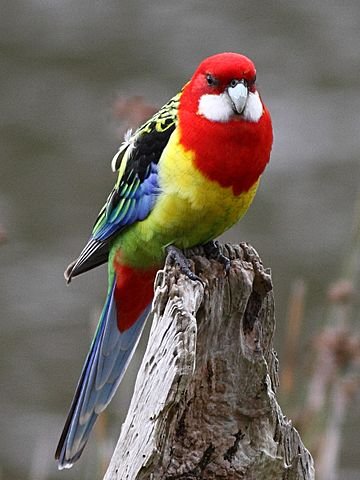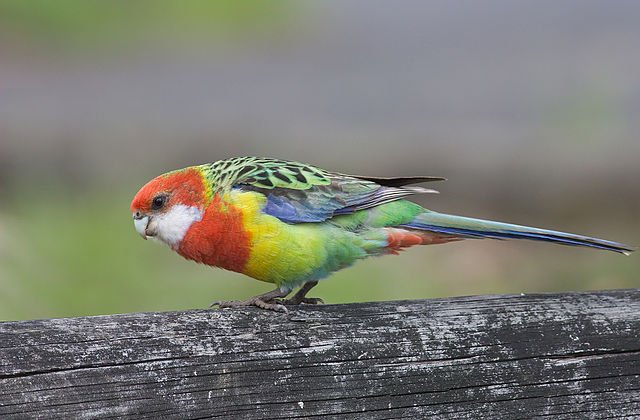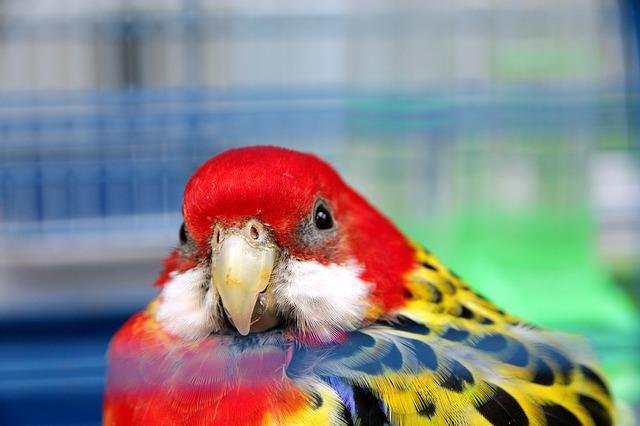Australia, being home to the world’s one-sixth parrot species, is a parrot’s paradise in a real sense. And for the most commonly seen species that one can see even in backyards is Eastern Rosella.
That also earned the species another name of being popularly referred to as the Common Rosella. But even this species has some subspecies and gender differences that make the people keep the guessing game on. Let’s understand all the physical differences within the species itself.
Male Eastern Rosella Visual Sexing
There aren’t many differences between the male and female Eastern Rosellas. The male Eastern Rosellas can be distinguished from the females on a few physical parameters.
Size
The Eastern males are comparatively larger than their female counterparts. The average size of a male Eastern could range anywhere between 11.7 to 12.7 inches.
Weight
The weight of an Eastern Rosella is around 120 grams approximately. They are a bit heavier than the female Easterns.
Wingspan
The wingspan of a male Eastern is large and ranges between 6 to 7 inches.
Bill
The bills of all the male Eastern Rosella are bigger and wider than their female counterparts. If noticed carefully, the difference is prominent enough to differentiate between both of the sexes.
Colors and Markings
Every subspecies of Easterns have varying colors and markings. Let us read them all one by one for a better clarity.
Platycercus Eximius Eximius- Also known as Eastern Rosella, this subspecies is commonly found throughout the southern region of New South Wales along with Victoria. The species has a rich scarlet-red head, neck, and back of the head. The breast is of a brighter shade of daffodil-yellow and the abdomen and flanks are aqua-blue. The eye-rings can be grey to dark grey. The irises are a darker shade of brown. The feet of the Easterns are also grey.

Talking about the tail and the wings, it has elaborate colors with under-tail coverts being red like his head. The outer-wing coverts and the bend of the wing both are blue. The underside of the tail is blue. The cheeks patches and the beak are white. The nape and back are black with greenish-yellow edges. And the rump is bright green.
Platycercus Eximius Cecilae – Primarily inhabiting the northeastern region of New South Wales and southeastern one of Queensland, this subspecies is more commonly known as Golden Mantled Rosella. Much like Eastern Rosella subspecies, the only distinct marking that is enough to tell them apart is the golden-yellow edges of the black back feathers against the greenish-yellow edges of subspecies Eastern Rosella.
These bright-golden hued edges can be seen on the feathers of the wings and the mantle too. Another difference from the subspecies Eastern Rosellas is the blue hue on the rump and the vent instead of the green as in the other subspecies.
Platycercus Eximius Diemenensis– Popularly known as the Tasmanian Eastern Rosella, the subspecies is widely found in the eastern Tasmanian region and the surrounding areas. The region almost exclusively belongs to this subspecies and an Eastern Rosella spotted in Tasmania is proof enough of him being a Tasmanian Eastern only.
But to clear any confusion, look for the larger and cleaner white patches on the cheek. Also, the plumage color on the head is of a noticeably darker shade. The subspecies has brighter and bigger birds than the abovementioned subspecies.
There are a few behavioral differences between both the sexes of the Eastern Rosellas. The male Easterns are more aggressive than their female counterparts. Being territorial is another behavioral trait of the males that sets them apart from the females. Their territorial nature also makes them unable to cohabitate with other Eastern pairs in the aviary, especially during breeding season.
Female Eastern Rosella Visual Sexing
The female Eastern Rosellas can be distinguished from the males on a few visual parameters.
Size
The size of the female Easterns is slightly smaller than the males. It ranges somewhere between 10 to 11 inches.
Weight
Comparatively lighter than the male Easterns, the females weigh around 100 grams at an average.
Wingspan
The wingspan of the female Eastern also varies with her size. The range is around 5 to 6 inches but it is still narrower than the male Easterns.
Bill
The beaks of the female Easterns are noticeably different from males. They are not only smaller in size but also narrower than the males. Also, they are distinguishably more rounder.
Colors and Markings
Platycercus Eximius Eximius – The subspecies is commonly found in coastal areas of New South Wales and throughout Victoria sharing tree-top nests with their mates. The female Easterns are also similar in basic color patterns and markings. But some noticeable differences can make an expert identify the gender of the birds apart.
The foremost difference is the color of the plumage in females that happens to be a duller shade of red. The bills of the females are also narrower than their male counterparts. The other colors of the plumage like green and blue are also less brighter than that of their counterparts. Additionally, the females have a white under-wing stripe.
Platycercus Eximius Cecilae – Just like males, the female Golden Mantled Rosellas are also found in the northeastern region of New South Wales and southeastern one of Queensland. There isn’t differentiation in colors and markings in both the genders of these subspecies. But there surely exists the basic differences of sexes, i.e., an overall duller plumage in the case of females and the bills being much smaller and narrower than the males.
Platycercus Eximius Diemenensis– Cohabiting the male Tasmanian Eastern Rosella, the females can also be found in the eastern Tasmanian region and the surrounding areas. Just like other subspecies, there are hardly any differences in colors and markings. The only difference is the small size, a rather rounder head, a duller plumage, and a smaller and narrower bill.
Behavior
A female Eastern can be easily identified among an Eastern pair being the one that is extremely shy and calm. Female Easterns do not get as aggressive as the males do. Neither are they much territorial when housed with their mates. Though sharing the same cage another Eastern pair can make them a bit aggressive and nippy. But the aggression will be milder when compared to her mate.
Eastern Rosella Sexing
Even after knowing that it is not a sure-shot way, everyone mostly relies on the above mentioned visual sexing techniques to differentiate both the genders. But if one has to be more than sure about his Eastern’s gender, going for either of the following two methods will assure accuracy:
DNA Sexing
The foremost method is DNA sexing that involves getting the bird’s DNA tested. Under this method, the vet takes a blood sample of the bird which is then sent to the laboratory for examination. The report after a few days tells the accurate gender of the bird.
Another way is to get the DNA tested with the help of the bird’s feather. This process involves plucking a few feathers of the bird from his abdomen area and sending them for DNA testing directly to the laboratory. The report gives the accurate sex of the bird. If the owner is doing this at home, care must be taken while plucking his pet bird’s feathers, as the bird might catch an infection due to improper feather plucking.
Surgical Sexing
Surgical sexing is a more traditional way of sexing a bird. But after the introduction of DNA sexing, surgical sexing faded off due to its invasive nature. The technique involves inspecting the organs of the bird to know his gender accurately.
Firstly, anesthesia is given to the bird to reduce the surgical pain he might experience during the procedure. An incision is then made by shaving off the small region of his abdomen. An endoscope is then made to pass through that incision to examine the bird’s reproductive organs.
Surgical sexing is as accurate as DNA sexing but it is being less used these days because of the pain and stress experienced by the bird. Additionally, if the post-surgical care is not up to the mark, the bird might catch an infection that can prove fatal to him, more often than not.
Summing Up
Eastern Rosellas are monomorphic and both the sexes can hardly be told apart if not sexed medically. Though many experts like vets and experienced bird-keepers can surely tell both the genders apart, the owners or breeders willing to breed a pair in the future must ensure the accurate gender before adopting. Simply assuming that two Easterns housed together in a pet store are of the opposite sex is the biggest mistake many owners commit. So, double-check their gender by following the scientific route only.
Read more about Eastern Rosella Diet
https://parrotquaker.com/eastern-rosella-diet/



